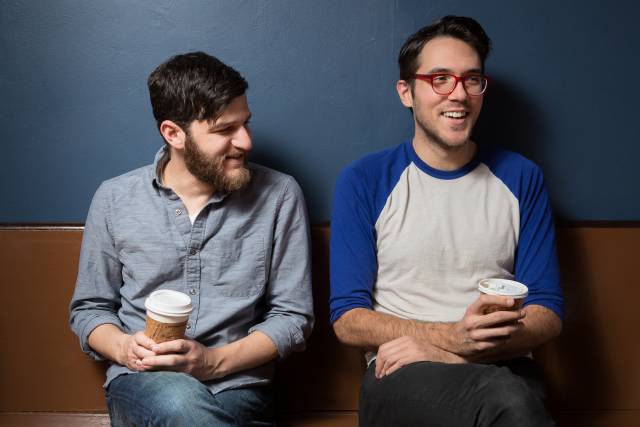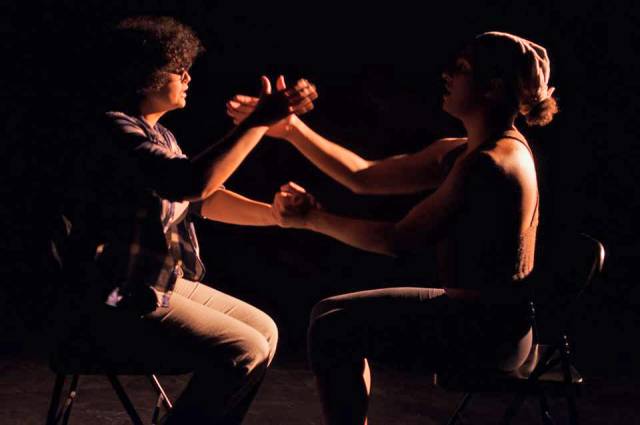

Shortly after the 2016 presidential election, we saw a rare moment of truth in one of the President Elect’s tweets when he exclaimed that “the Theater must always be a safe and special place” in the aftermath of his Vice President’s visit to Hamilton, where he was addressed by the multicultural, multiethnic cast after the curtain call. While the intention behind his tweet was to chastise free speech, and criticism of his racist, misogynistic rhetoric, his words are true; theatre should be a safe space for audiences and artists to engage in a conversation about the state of the world. As anxieties rise in the artistic community over what the future holds under an extreme right wing regime, there is also a glimmer of hope as seen in how quickly the artistic community has organized by setting up vigils, peaceful protests, and concerts meant to remind us that not all is lost.
One of the most fascinating projects to spring from the election is Sanctuary, a program being held at HERE from January 20 to February 18, meant to offer a space for queer, female, people of color, and other marginalized voices to be heard. Produced by Adam Salberg and Jonathan Cottle (in association with Less Than Rent Theatre) the program will feature over a dozen shows meant to bring together artists and audiences who will have the safe space PEOTUS demanded. I spoke to Cottle and Salberg about how they put together this program in such a short time, the power of theatre in creating change, and how escapism and activism can go hand in hand.
Theatre is criticized for taking too long to reflect “real life”. Sanctuary was developed so fast and in direct response to real life, how has this process been?
Adam Salberg: It was a scramble getting everything together so quickly. We had this opportunity where the space became available at the same time as the Inauguration, so we thought it was a great chance to bring together artists who have something to say, and giving them access to a stage they wouldn’t necessarily have been able to get to. You’re right, we’re trying to cram six months of work into six weeks, but the enthusiasm of people in the industry has been great.
Usually we go to theater as an escape, Sanctuary will be about commiserating. Can you talk about how theater can also be a place for us to mourn?
Jonathan Cottle: I’ve always been more of the mindset that theatre should be about imagining beyond escapism, to think about the world we can create, or things from our past that need to be reflected upon, celebrated or mourned. This is all of those things. When we reached out to performers we didn’t offer specific prompts, we didn’t ask them to create pieces about the election or their fear of Trump’s presidency. We wanted to reflect the different voices that will affected by the presidency. All artists will be affected, so in our Inaugural Ball we wanted to also offer escapism. I don’t think people will forget what’s going on, but there is something radical about being with a group of people who are trying to fight. We’ll be thriving in spite of the harsh times ahead.
What was some of the criteria for selecting the pieces?
Adam Salberg: We decided early on that we wanted to promote feminist, minority and queer voices. We’re both white cisgender men, so for the selection process we put together a team of industry people to go over the submissions, we pushed the submission process as much as we could. I’m very happy with the response we received, I think we have an incredible diversity of perspective and opinions. When you’re talking about promoting diversity it’s never a binary issue. I don’t want to rest on our laurels and say we hit the mark, we had the fear we would get an overwhelming number of submissions from upper middle class, white, gay men, because they fit the criteria as queer artists, but they have more opportunities. We had those submissions, but I’m happy we also had a wider range of backgrounds.

Neither of you are producers, what you’re doing right now is kind of a great metaphor for what should be going on in terms of grassroots movements and community organization, a reminder that you don’t need to be a politician to rally people and inspire change. When did you first realize theatre had this power?
Adam Salberg: I’m always interested in projects that deal with social and political conscience. For Sanctuary, there’s a sense everybody wants to respond to the election and social justice, but it’s like a participatory sport, you have to get up and do it. Things like representation in theatre for instance, you don’t have productions of The Mikado with an all-white cast happening without people questioning it. But in terms of having a more diverse theatre, I think the will to do something is there but the gap is no one knows how to start. We’re not producers, but we saw an opportunity and a need for this work to be done right now. To be honest no one else was going to do it, and we thought it was our responsibility to do it, so we thought we would try to pull it off. We didn’t want this opportunity to pass us and regret it later. This happens too often, it’s very easy to make excuses, so unless you take the first step, no one will do it.
You’re both designers, can you talk about how politics have affected specific projects you’ve worked on in terms of aesthetics?
Jonathan Cottle: Sanctuary is one of the most intense moments, but thinking about the past two years, I had just finished a bunch of projects before the election, so when that happened I was thankful I’d finished those projects because it would’ve been hard to work on those. I’m seeing a lot of people on Facebook, playwrights and designers, who are talking about how they’re finding it difficult to work and function like they did before November 8th.
What are some of the design elements that will come into play in Sanctuary?
Jonathan Cottle: I am drawing upon visual research from countercultural and protest movements of the last 100 years. Things like the Weimar Republic Berlin, early 90s punk girl riot scene in Seattle, they weren’t traditional protest movements but they were politically charged. My intention there will be to create rich environments for the pieces, but also to remind people that every kind of reaction to an oppressive force has precedents. One of the best tools oppressors have is make people forget that everything has been done before and that we can draw from history. It’s easy to oppress when activists think they have to build the movement from nothing. In design I want to remind people that’s not the case, we have historical precedent that can make us stronger.
One of the most horrifying things about the election is how much the new President, his party and supporters refuse to engage with intellect. As artists in New York, are you interested in outreach to people who would never dream of seeing things done by liberals?
Jonathan Cottle: Everyone’s hope when they do something with a political message is that people will see it. I’m a strong believer that art is not explicitly action, but the conversation that can incite action. We chose the name Sanctuary for this because this is step one, we’re focusing on survival and letting the people who are under attack thrive. Changing minds comes later, the most radical action people can take now is survive so we can change this nightmare later. We wanted to create a place for people to share their work, we want to create the “safe space” conservatives demonize and which Trump demanded after the Hamilton incident. I don’t think safe spaces should be apolitical, it doesn’t mean ignoring things that make us uncomfortable, but facilitating a place where we can in fact discuss these things.
Adam Salberg: I’m afraid for the people I love, but as an artist this is a call to action. A big part of the program is engaging artists and industry leaders in this conversation. Is the issue that we need to engage more and tell more stories about rural white America? Do we need to be more compassionate or do we need to redouble efforts in telling our own stories? Should we humanize minority voices? I personally fall stronger on the latter side. I’m not saying everyone who voted for Trump is a racist or a misogynist, but I am going to say that he is, and voting for him was an act of racism and misogyny. I’m not interested in humanizing the perspective of his supporters, I’m interested in marginalizing it and lifting the voice of minorities.
For more information on Sanctuary visit https://here.org/shows/detail/1870/